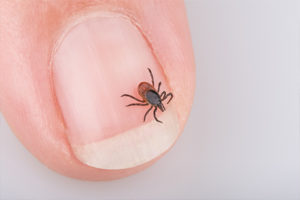
Ticks are becoming increasingly prevalent across North America, including here in Southern California. In our region, tick-borne diseases like ehrlichiosis and anaplasmosis are not only present—they are common, and we frequently diagnose them in both local dogs and those adopted from regions like Mexico and Arizona, where exposure is especially high.
Ticks transmit disease through their saliva while feeding on a host. These parasites may carry and spread serious, sometimes life-threatening infections, including:
- Ehrlichiosis
- Anaplasmosis
- Lyme disease
- Rocky Mountain spotted fever
- Babesiosis
- Tick paralysis
Signs of tick-borne illness in pets can be vague and may include joint pain, lameness, lethargy, fever, coughing, trouble breathing, loss of appetite, or unexplained weight loss. If your pet develops any of these symptoms, especially after recent outdoor activity, contact us right away.
Prevention Is Key
The best defense against ticks is consistent use of a veterinarian-approved tick preventive. We offer a range of safe and effective oral and topical preventives, many of which also protect against fleas and other parasites. Whether your pet is primarily indoors or frequently hikes with you outdoors, we’ll help you choose the product that best fits your lifestyle.
Even indoor-only pets are at risk, as ticks can be carried inside on clothing or shoes. That’s why prevention is important year-round.
Annual Tick-Borne Disease Testing
Each year, we recommend a simple in-house blood test that screens for heartworm disease, Lyme disease, Ehrlichia, and Anaplasma—all in one panel. It requires only a small blood sample and helps us catch infections early, often before symptoms appear.
What If You Find a Tick?
Don’t panic if you find a tick on your dog or cat—even pets on preventives can occasionally pick up ticks. Many products work by killing ticks after they attach, so finding one doesn’t mean your pet isn’t protected. Still, check your pet regularly, especially after time outdoors, focusing on areas like ears, under the collar, between the toes, and along the belly and groin.
To safely remove a tick from your pet, use a pair of fine-tipped tweezers and grasp the tick as close to the skin’s surface as possible. Apply steady, even pressure and pull upward—do not twist or jerk, as this can cause the mouthparts to break off and remain in the skin. Once the tick is removed, clean the area with antiseptic or soap and water, and wash your hands thoroughly. Dispose of the tick by placing it in alcohol, sealing it in a bag, or flushing it down the toilet—never crush a tick with your fingers. If you’re unsure whether you removed the entire tick or if the site becomes red, swollen, or irritated, contact us for guidance.
If you have any questions about ticks or disease prevention, our team is here to help. Call us to get your pet protected and tested today.

Contact Us
contactus@seacoastanimal.com
760-760-7973
Hours
Mon: 7:30 am – 5:30 pm
Tues: 7:30 am – 5:30 pm
Weds: Closed
Thurs: 7:30 am – 5:30 pm
Fri: 7:30 am – 5:30 pm
Sat/Sun: Closed
